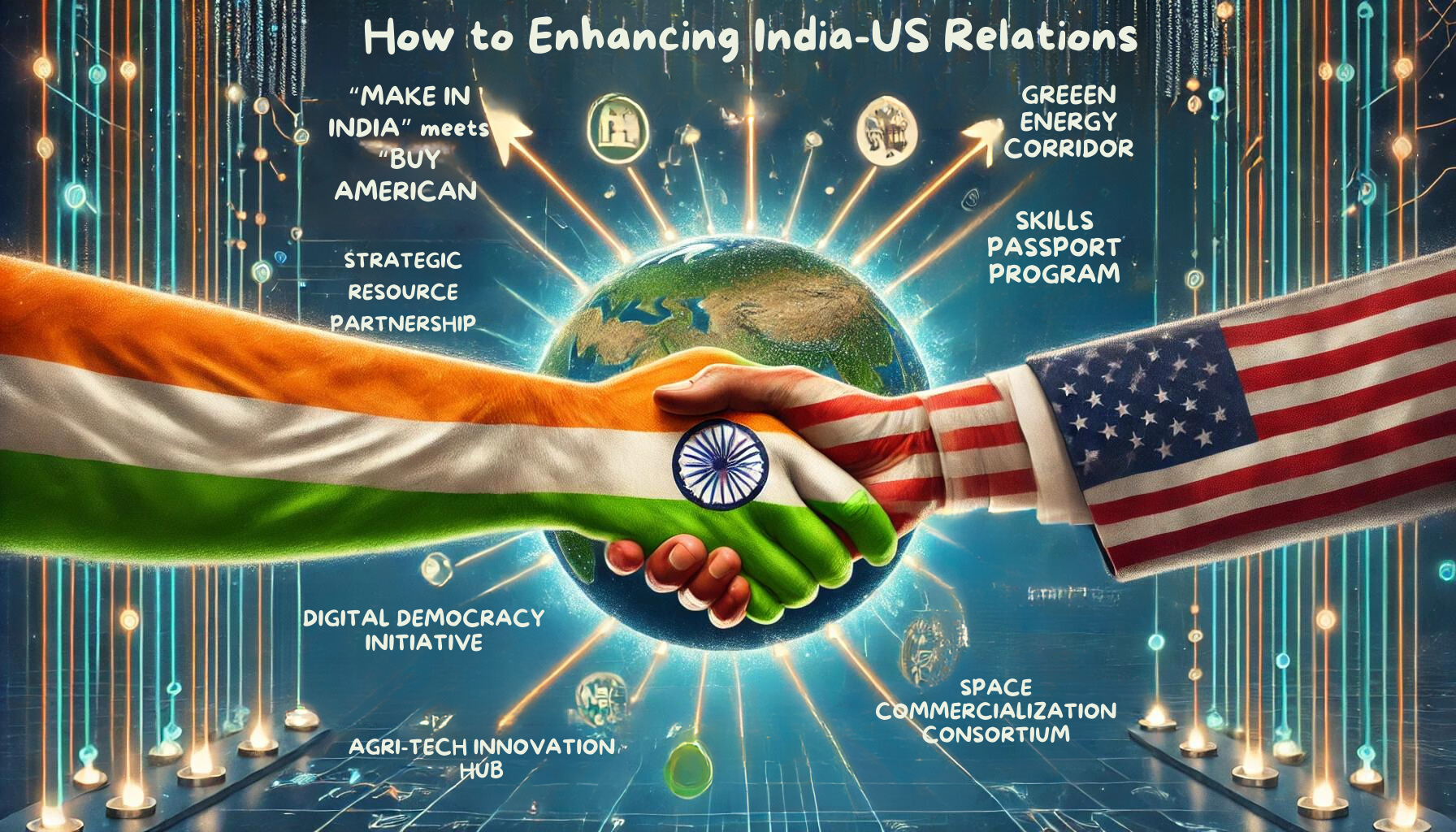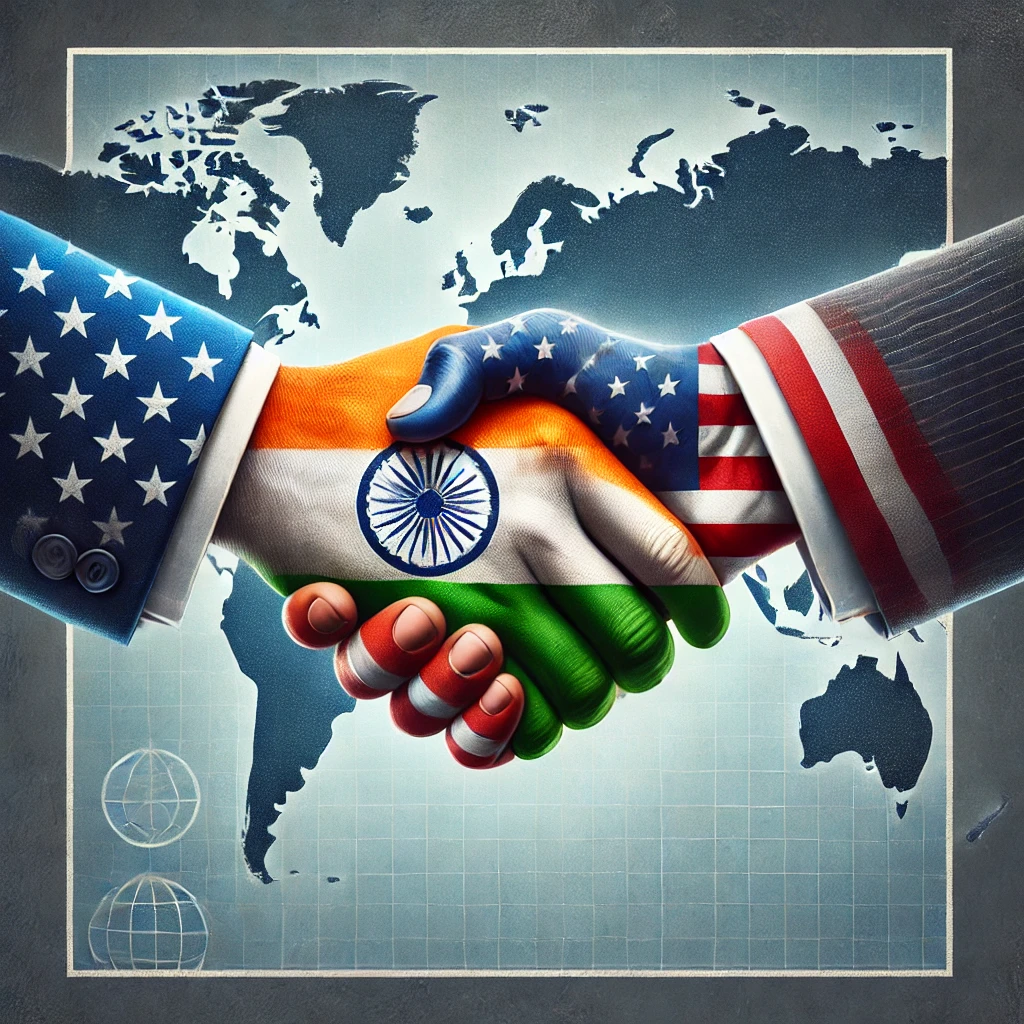India has managed to strengthen its relationship with the US under both Republican and Democratic administrations. This partnership spans various fields such as trade, technology, and security. However, challenges remain in areas like immigration, trade policies, and geopolitical alignments, especially concerning Russia and China. To navigate these complexities, India must utilize its strategic advantages, including strong engagement with US policymakers and robust ties with the Indian diaspora. This will help India adapt and strengthen its relationship with the US in an increasingly multipolar world.
| GS Paper | General Studies II |
| Topics for UPSC Prelims | India-US partnership, Cold War, Next Steps in Strategic Partnership, 2008 Civil Nuclear Agreement, 2008 Civil Nuclear Agreement, US-India Strategic Clean Energy Partnership, Critical and Emerging Technology Initiative, Quadrilateral Security Dialogue, US’s CAATSA sanctions, BRICS, Defense Technology and Trade Initiative, Green Energy Corridor. |
| Topics for UPSC Mains | Evolution of India-US Relations, Major Areas of Friction in India-US Relations. |
Origin of the Article
This editorial is based on “Whether it is President Trump or President Harris, US-India relations must continue on an upward arc,” published in The Indian Express on 26/08/2024. The article discusses India’s ability to maintain strong ties with the US through different administrations, leveraging strategic advantages like diaspora ties and its role in the Indo-Pacific region.
Relevancy for UPSC Students
For UPSC students, understanding India US relations is crucial as it covers topics in GS Paper 2, including Bilateral Groupings and Agreements, and the impact of international policies on India’s interests. Knowledge of this topic helps in answering questions related to international relations and geopolitics in both Prelims and Mains.
Why in News
The evolving dynamics of the India-US partnership have recently been in the spotlight due to potential political shifts in the United States. This topic is crucial for UPSC aspirants as it intersects with various aspects of international relations, bilateral agreements, and India’s strategic positioning. The consistent growth in India-US ties, despite political changes in the US, reflects India’s adept diplomacy and strategic use of its diaspora and geopolitical significance.
How India and US Relations Evolved?
The relationship between India and the United States has undergone a major transformation over the decades, evolving from cautious engagement to a deep strategic partnership. This journey has been shaped by shared democratic values and major alliances that play a pivotal role in regional and global affairs.
From Estrangement to The Cold War Thaw
During the Cold War, India and the US were on opposite sides, with India pursuing non-alignment and Pakistan aligning with the US. The relationship began to thaw in the 1990s with India’s economic liberalization and the end of the Cold War. A significant turning point was President Bill Clinton’s visit in 2000, marking a new era of strategic dialogue and economic cooperation, solidified by the Next Steps in Strategic Partnership (NSSP) in 2004.
Nuclear Breakthrough New Era of Trust
The 2008 Civil Nuclear Agreement marked a watershed moment, ending India’s nuclear isolation and recognizing it as a responsible nuclear power. This deal integrated India into the global nuclear order and expanded cooperation in defense and high-technology sectors, demonstrating the US’s commitment to elevating India’s global stature.
Defense Ties: From Buyer to Partner
India-US defense cooperation has grown exponentially, with India designated as a Major Defense Partner in 2016 and elevated to Strategic Trade Authorization Tier 1 status in 2018. Foundational agreements like LEMOA, COMCASA, and BECA have deepened military cooperation. Joint exercises and the 2+2 Ministerial Dialogue have further strengthened strategic ties.
Economic Synergy-Beyond Trade to Strategic Cooperation
Economic relations have been a key driver of the partnership, with bilateral trade reaching USD 118.28 billion in 2023-24. The US is now India’s largest trading partner and a significant source of FDI. Cooperation has expanded to clean energy, the digital economy, and healthcare, highlighted by initiatives like the US-India Strategic Clean Energy Partnership and Covid-19 vaccine collaboration.
Collaborating in the Digital Age
Technology cooperation has become a cornerstone, with forums for collaboration in AI, quantum computing, and 5G. The US-India Science and Technology Endowment Fund and recent initiatives like the US-India Artificial Intelligence Initiative underscore the strategic importance of tech cooperation in bilateral ties.
Geopolitical Alignment-Partners in the Indo-Pacific
The rise of China has brought India and the US closer in their strategic outlook. The revival of the Quadrilateral Security Dialogue (Quad) and India’s inclusion in the US Indo-Pacific strategy reflect this alignment. Joint statements on a “free and open Indo-Pacific” and initiatives like the Supply Chain Resilience Initiative demonstrate the depth of geopolitical cooperation.
What are the Major Areas of Friction in India-US Relations?
Despite the strong ties, India US relations have seen friction points, primarily stemming from trade disputes, and differing stances on regional policies and human rights. These areas of contention require careful navigation to sustain and enhance the bilateral partnership.
Trade Tensions-Navigating Economic Choppy Waters
Despite growing bilateral trade, economic frictions persist. Issues include India’s trade surplus, market access barriers, and intellectual property rights concerns. The US has criticized India’s data localization policies and e-commerce regulations, while India has objected to US tariffs on steel and aluminum. The removal of India from the Generalized System of Preferences (GSP) in 2019 complicates trade relations.
Strategic Autonomy vs. Alliance Expectations
India’s policy of strategic autonomy often clashes with US expectations. This is evident in India’s stance on the Russia-Ukraine War and its continued purchase of Russian military equipment. The US’s CAATSA sanctions threat and India’s participation in groupings like BRICS and SCO create friction, making it challenging to balance divergent interests while maintaining a strong partnership.
Technology Transfer and Defense Cooperation
While defense ties have improved, issues persist in technology transfer and joint production. US export control regulations often limit technology sharing. Implementation lags of agreements like COMCASA and BECA due to Indian concerns about information security also impact deeper defense cooperation. The Defense Technology and Trade Initiative (DTTI) aims to address these issues, but progress has been slow.
Human Rights and Democratic Values
US concerns over human rights issues in India, including religious freedom and treatment of minorities, occasionally strain relations. The US Commission on International Religious Freedom’s recommendations to designate India as a “country of particular concern” highlight these tensions. Balancing strategic partnership with values-based diplomacy remains a challenge.
Visa and Immigration
Immigration policies affecting Indian tech workers and students have been a persistent issue. Changes to H-1B visa rules and the backlog for employment-based green cards, disproportionately affecting Indians, remain major irritants. Over 1 million Indians are waiting for highly skilled immigration visas.
Climate Change and Energy
While both countries are committed to addressing climate change, differences persist over the pace and scale of action. The US pushes for more ambitious emission reduction targets, while India emphasizes its development needs and calls for greater financial support from developed nations. Disagreements over carbon border taxes and coal pricing highlight the challenges.
Intellectual Property Rights
IPR protection remains contentious. The US has placed India on its Priority Watch List, citing concerns over patent laws, copyright piracy, and trademark infringement. India’s use of compulsory licensing for pharmaceuticals and its stance on agricultural patents have been points of friction. Despite efforts to strengthen its IPR regime, differences persist.
How Can India Further Enhance its Relations With the US?
India can further enhance its relationship with the US by deepening cooperation in emerging sectors such as technology, space, and climate change initiatives. Strengthening people-to-people ties and strategic dialogues can also pave the way for a more flexible and mixed partnership.

“Make in India” Meets “Buy American”
India can propose joint manufacturing initiatives in sectors like electronics, pharmaceuticals, and defense. Fast-track approval processes and special economic zones tailored for US companies could make this initiative attractive, addressing US concerns about job creation while boosting India’s manufacturing capabilities.
Green Energy Corridor
India can propose a bilateral Green Energy Corridor focusing on joint development and production of renewable energy technologies. Collaborative research on solar, wind, and hydrogen technologies, along with joint ventures for manufacturing green energy equipment, could accelerate both countries’ clean energy transitions.
Digital Democracy Initiative
A Digital Democracy Initiative focusing on shared norms and technologies for an open, secure internet can be proposed. Joint efforts in cybersecurity, countering disinformation, and promoting digital literacy can align digital governance approaches, addressing US concerns about India’s tech policies while asserting its role in global digital norms.
Skills Passport Program
A Skills Passport Program to address US labor shortages while providing opportunities for Indian workers can be proposed. This program would involve standardized skill certification, streamlined visa processes, and joint training programs in high-demand sectors like healthcare, IT, and advanced manufacturing.
Strategic Resource Partnership
India can offer to become a key partner in securing and diversifying US supply chains for critical resources. Joint exploration and production of rare earth elements and collaborative research on alternative materials can position India as a reliable alternative to China in critical supply chains.
Pandemic Preparedness and Beyond
Building on COVID-19 cooperation, India can propose a comprehensive Health Security Alliance. This could include joint vaccine development, collaborative research on emerging infectious diseases, and shared early warning systems, extending to telemedicine, medical device development, and health data analytics.
Space Commercialization Consortium
India can initiate a Space Commercialization Consortium focusing on the joint development of commercial space technologies. Collaborative projects in small satellite development, space-based internet services, and space tourism technologies can combine ISRO’s cost-effective approach with NASA’s advanced capabilities.
AgriTech Innovation Hub
An AgriTech Innovation Hub focusing on advanced agricultural technologies can be established. Joint research on climate-resilient crops, precision farming techniques, and AI-driven pest management systems can combine US agricultural research capabilities with India’s diverse agro-climatic zones, enhancing food security innovations.
Conclusion
In conclusion, the India-US partnership is a cornerstone of India’s foreign policy, reflecting our strategic adaptability and resilience. As civil services aspirants, it is crucial to understand the multifaceted nature of this relationship, including its challenges and opportunities. By leveraging our strengths and navigating complexities, India can continue to enhance this vital alliance in an increasingly multipolar world.
| UPSC Civil Services Examination, Previous Year Questions (PYQs) Mains Q. Discuss the key challenges in making India a global manufacturing hub and how the ‘Make in India’ initiative can overcome these challenges. (GS Paper III, 2022) Q. Evaluate the impact of the Quadrilateral Security Dialogue (Quad) on India-US relations. Discuss how this multilateral engagement affects India’s strategic positioning in the Indo-Pacific region, particularly in the context of balancing relations with China and Russia. |



